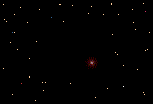



|
|
|
|
|
|
|
Hubble peers into the heart of the densest known star cluster![[M15, HST]](media/m15gc_s.jpg) This mosaic of the globular cluster M15 contains over 30,000 stars. The
Hubble Space Telescope probed the core of M15, the most tightly packed
cluster of stars in our galaxy, to look for evidence of either a massive
black hole or another remarkable phenomenon: a "core collapse" driven by the
intense gravitational pull of so many stars in such a small volume of space.
This mosaic of the globular cluster M15 contains over 30,000 stars. The
Hubble Space Telescope probed the core of M15, the most tightly packed
cluster of stars in our galaxy, to look for evidence of either a massive
black hole or another remarkable phenomenon: a "core collapse" driven by the
intense gravitational pull of so many stars in such a small volume of space.
The larger picture shows the central portion of M15, photographed with Hubble's Wide Field Planetary Camera 2. The image is about 28 light- years across. The cluster center is in the upper right, on the highest- resolution part of the image. The inset is an enlargement of the innermost 1.6 light-years of the cluster. Images in ultraviolet, blue, and visual light were combined for this picture, so that the colors roughly correspond to the surface temperatures of stars in M15. Hot stars appear blue, while cooler stars appear reddish-orange. The density of stars rises all the way into the cluster center, marked by a green cross. Careful analysis of the distribution of these stars suggest that at some point in the distant past, the stars converged on M15's core, like bees swarming to their hive. This runaway collapse, long theorized by researchers but never seen in such detail, may have lasted a few million years--a flash in the 12-billion-year life of the cluster. A precise reading of the speeds at which stars move near M15's core would reveal whether the stars are packed so tightly because of the influence of a single massive object, or simply by their own mutual attraction. Stars would orbit more quickly in the gravitational grip of a black hole, which would be several thousand times more massive than our sun. Such measurements are time consuming but possible with Hubble. The images were taken in April 1994 and will be published in the January 1996 issue of Astronomical Journal. Members of the research team are Puragra Guhathakurta (UCO/Lick Observatory, UC Santa Cruz), Brian Yanny (Fermi National Accelerator Laboratory), Donald Schneider (Pennsylvania State University), and John Bahcall (Institute for Advanced Study). Credit: P. Guhathakurta (UCO/Lick Observatory, UC Santa Cruz), B. Yanny (Fermi National Accelerator Lab), D. Schneider (Pennsylvania State Univ.), J. Bahcall (Inst. for Advanced Study), and NASA.
|
|
|
M15
Number of Frames: 44 Exposure: 15s ISO 1600 Equipment: Takahashi FS-102NS, f/8, Canon EOS300D camera in prime focus Date: 05-09-13 Reduced, aligned and stacked with ImagesPlus; final processing with Photoshop CS |
|
|
|
This site was last updated 2006-12-14 Site created and maintained by Jorge Lázaro